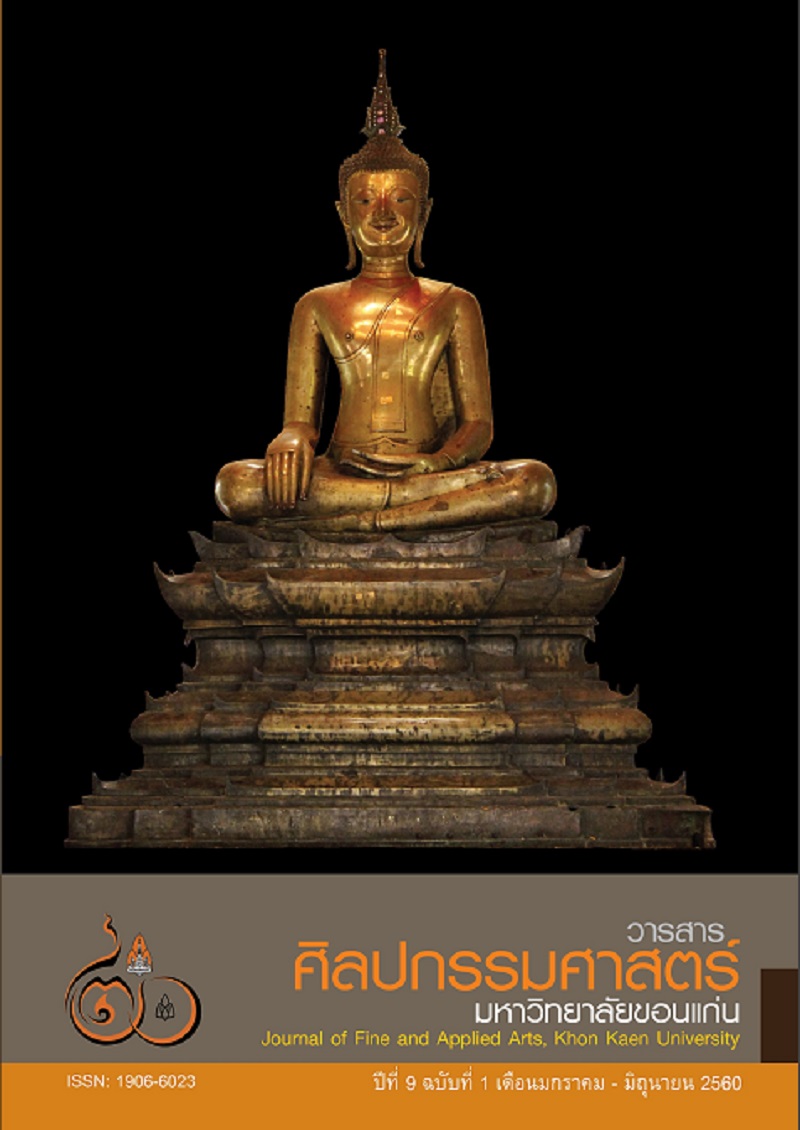เทคนิควิธีการลำของหมอลำฉลาด ส่งเสริม (ป. ฉลาดน้อย) Techniques In Moo-Lum of Chalad Soongsraem (Poo.Chaladnoy)
Main Article Content
Abstract
งานวิจัยเรื่องนี้ มีความมุ่งหมายเพื่อศึกษา 1) เพื่อศึกษาเทคนิควิธีการลำทำนองอุบลฯ ของหมอลำ ป. ฉลาดน้อย 2) เพื่อวิเคราะห์สุนทรียภาพของการลำทำนองอุบลฯ ของหมอลำ ป. ฉลาดน้อย โดยใช้วิธีการศึกษาจากเอกสารและภาคสนามด้วยการสังเกตและสัมภาษณ์จากผู้รู้ นำเสนอผลการศึกษาวิจัยด้วยวิธีการพรรณนาวิเคราะห์ ผลการศึกษาปรากฏดังนี้
1. เทคนิควิธีการลำทำนองอุบลฯ ของหมอลำ ป. ฉลาดน้อย พบว่าเทคนิคการลำทำนองอุบลฯ ของหมอลำ ป. ฉลาดน้อย สามารถแยกออกเป็น 24 เทคนิควิธี คือ 1) เทคนิควิธีการครั่นเสียง 2) เทคนิควิธีการกระทบเสียง 3) เทคนิควิธีการเน้นเสียง 4) เทคนิควิธีการประคบเสียง 5) เทคนิควิธีการกล่อมเสียง 6) เทคนิควิธีการกลิ้งเสียง 7) เทคนิควิธีการกลืนเสียง 8) เทคนิควิธีการขยักเสียง 9) เทคนิควิธีการควงเสียง 10) เทคนิควิธีการช้อนเสียง 11) เทคนิคการปั้นเสียงหรือปั้นคำ 12) เทคนิควิธีการปริบเสียง 13) เทคนิควิธีการโปรยเสียง 14) เทคนิควิธีการผ่อนเสียง 15) เทคนิควิธีการม้วนเสียง 16) เทคนิควิธีการโยกเสียง 17) เทคนิควิธีการโยนเสียง 18) เทคนิควิธีการรวบเสียง 19) เทคนิควิธีการทำเสียงหนัก เสียงเบา 20) เทคนิควิธีการทำหางเสียง 21) เทคนิควิธีการโหนเสียง 22) เทคนิควิธีการอมเสียง 23) เทคนิควิธีการสะบัดเสียง 24) เทคนิควิธีการเล่นคำ และยังพบว่าหมอลำ ป.ฉลาดน้อย ได้นำเทคนิคที่ได้จากการประดิษฐ์การเอื้อนมาใส่ในการลำทำนองอุบลฯได้อย่างสละสลวยไม่ว่าจะเป็นการเกริ่น การเดินกลอน และการจบกลอน และยังมีลีลาในการเปล่งเสียงที่โดดจากคีย์และกลับมาคีย์เดิมได้โดยไม่เพี้ยนเสียง โดยมีวิธีการเอื้อนเสียงทั้งหมด 30 เสียง คือ 1. เสียง โอ 2. เสียง โอ่ 3. เสียง โอ้ 4. เสียง โอ๊ 5. เสียง โอ๋ 6. เสียง โอะ 7. เสียง โฮะ 8. เสียง อึ 9. เสียง ฮึ 10. เสียง อื 11. เสียง ฮื 12.เสียง อา 13. เสียง ฮา 14. เสียง อ่ำ 15. เสียง เออ 16.เสียง เอ่อ 17. เสียง เอ้อ 18. เสียง เอ๋อ 19. เสียง เฮอ 20. เสียง เอ 21. เสียง เอ่ 22. เสียง เอ๋ 23. เสียง อิ 24. เสียง อี 25. เสียง ออ 26. เสียง อ่อ 27. เสียง อ๋อ 28. เสียง เอาะ 29. เสียง อ๋อย 30. เสียง โอ๋ย
2. สุนทรียภาพของการลำทำนองอุบลฯ ของหมอลำ ป. ฉลาดน้อย พบว่าสุนทรียภาพของการลำทำนองอุบลฯ สามารถแบ่งออกได้ 7 ลักษณะอารมณ์ คือ 1) รัก 2) โศกเศร้า 3) อาลัยอาวรณ์ 4) โกรธ 5) ตื่นเต้นดีใจ 6) น้อยเนื้อต่ำใจ และ 7) ห่วงใย การถ่ายทอดอารมณ์เหล่านี้เป็นการถ่ายทอดอารมณ์ในการลำตามลักษณะการประพันธ์ ทำนองลำทางยาว ในบทเน้นคำและลากเสียงให้ยาวสื่อความรู้สึกทางอารมณ์ได้ดี
The purposes of this study were 1. To the study aimed at Moo – Lum of Poo Chaladnoy’s Ubon melody style 2. To Moo – Lum of Poo Chaladnoy’s Ubon melody aesthetic was used for data analysis data was analyzed using by means of document study and field observation and interviews with those who know. Presented the results of research by means of descriptive analysis. As shown below
1.Techniques In Moo-Lum of Poo-Chaladnoy can be separated into 5 techniques. Is 1) Utter sounds techniques 2) The sound effects techniques 3) Sound Sado techniques 4) The sound node techniques 5) The use words of Tag techniques. And Also found Moo – Lum of Poo Chaladnoy brought the invention of utter the into a trunk melody Ubon is The introductory sing the verse or to complete the verse get the rhetoric and also voiced the distinctive style of the original key and back key without distortion.
2. Aesthetic of Techniques In Moo-Lum Poo-Chaladnoy found Aesthetics of the trunk melody Ubon. Can be divided into 7 emotional is 1.) fond 2.) bewail 3.) mourn 4.) furious 5.) excited 6.) disappoint and 7.) feel anxious about.
Article Details
Content and information in articles published in the Journal of Fine and Applied Arts of Khon Kaen University is regarded as the opinion and sole responsibility of the author(s) directly; therefore, editors are not obliged to agree to or share any responsibility with regard to the content and information that appears within these articles.
All articles, information, content, image, etc. that have been published in the Journal of Fine and Applied Arts of Khon Kaen University is the copyright of the Journal of Fine and Appllied Arts of Khon Kaen University. Any person or organization who wishes to distribute all or parts of the articles for further dissemination or other usage must first receive permission from the Journal of Fine and Applied Arts of Khon Kaen University before proceeding to do so.


